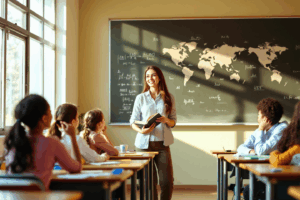Distinguishing between “there,” “their,” and “they’re” can be challenging, but several practical tips can help remember and apply the correct usage consistently. These strategies focus on understanding the fundamental differences in meaning and function, which can enhance both writing and speaking skills.
Contextual Association:

There: Think of the word “here” within “there” to remember its association with place or location. When you’re talking about a place or pointing something out, use “there.”
Their: Contains “heir,” which can remind you of inheritance or possession. Use “their” when referring to something that belongs to someone.
They’re: Break it down to “they are.” If you can replace the word with “they are,” and the sentence still makes sense, then “they’re” is the correct choice.
Mnemonic Devices:

Use the phrase, “Where there is a T, there is a place,” to remember that “there” refers to a location.
For “their,” keep in mind the guideline: “I before E, except after C, or when sounding like ‘A’ as in neighbor and weigh… however, in ‘their,’ the ‘I’ precedes the ‘E’ to denote possession.”
3. Practice with Replacement:

Try replacing the homophones with their meanings. If the sentence does not make sense with “they are,” don’t use “they’re.”
Practice rewriting sentences by replacing “there” and “their” to see which makes sense. This method reinforces understanding through active use.
Proofreading:

Always proofread your writing for these homophones. Checking each sentence for context can catch mistakes before they reach the reader.
Read it out loud: Listening to the sentence can often clarify whether to use “there,” “their,” or “they’re” based on the sentence’s context.
By incorporating these tips into daily writing and speaking habits, individuals can significantly reduce errors related to these homophones. Regular practice and mindfulness in applying these strategies will improve both the accuracy and clarity of communication, leading to more effective and confident language use.





 Homophones are words that sound the same but differ in meaning, spelling, or both, making them some of the trickier components of the English language to learn. The reason they cause confusion is primarily due to their similar sound, which can lead to errors in writing, especially when the nuances of their meanings are not well understood. These mistakes are not just common among learners of English but also occasionally trip up native speakers.
Homophones are words that sound the same but differ in meaning, spelling, or both, making them some of the trickier components of the English language to learn. The reason they cause confusion is primarily due to their similar sound, which can lead to errors in writing, especially when the nuances of their meanings are not well understood. These mistakes are not just common among learners of English but also occasionally trip up native speakers. Understanding and mastering the correct usage of homophones is crucial because they can significantly affect the clarity of communication. Misusing homophones can lead to misunderstandings and ambiguity in written texts. To use them correctly, it is essential to grasp their definitions and the context in which they are used. This understanding begins with exploring each homophone in detail, starting with the commonly mixed-up trio: “there,” “their,” and “they’re.”
Understanding and mastering the correct usage of homophones is crucial because they can significantly affect the clarity of communication. Misusing homophones can lead to misunderstandings and ambiguity in written texts. To use them correctly, it is essential to grasp their definitions and the context in which they are used. This understanding begins with exploring each homophone in detail, starting with the commonly mixed-up trio: “there,” “their,” and “they’re.”
 Furthermore, “there” can function as a noun, although this usage is less common. In this capacity, it refers to a state or condition, as in the phrase “getting from here to there.” This usage is more abstract and is often philosophical or reflective about the journey between two different states or conditions.
Furthermore, “there” can function as a noun, although this usage is less common. In this capacity, it refers to a state or condition, as in the phrase “getting from here to there.” This usage is more abstract and is often philosophical or reflective about the journey between two different states or conditions. The versatility of “there” can make it confusing, but the key to understanding its correct application lies in context. Whether indicating a location, introducing a sentence, or describing a state, “there” is always used to point out or declare something. It is never used to denote possession, which is where it often gets confused with “their.”
The versatility of “there” can make it confusing, but the key to understanding its correct application lies in context. Whether indicating a location, introducing a sentence, or describing a state, “there” is always used to point out or declare something. It is never used to denote possession, which is where it often gets confused with “their.” The word “their” is a possessive adjective used to indicate ownership or association belonging to some specific people or things previously mentioned or easily identified in the context. Unlike “there,” which relates to location or existence, “their” refers directly to possessions or associations with people, animals, or things. It always precedes a noun, modifying it to denote possession.
The word “their” is a possessive adjective used to indicate ownership or association belonging to some specific people or things previously mentioned or easily identified in the context. Unlike “there,” which relates to location or existence, “their” refers directly to possessions or associations with people, animals, or things. It always precedes a noun, modifying it to denote possession. The confusion often arises not from its usage but from its sound, which is homophonous with “there” and “they’re.” This can lead to errors in writing where one might incorrectly substitute “their” with one of these homophones. However, remembering that “there” is always used in contexts of ownership can help clarify its correct application.
The confusion often arises not from its usage but from its sound, which is homophonous with “there” and “they’re.” This can lead to errors in writing where one might incorrectly substitute “their” with one of these homophones. However, remembering that “there” is always used in contexts of ownership can help clarify its correct application. Because “their” addresses ownership, it is inherently plural, though it is also used singularly in cases respecting gender neutrality, such as in “Someone left their book on the table.” Here, “their” allows for an unspecified gender of the person who owns the book, aligning with contemporary efforts to use inclusive language.
Because “their” addresses ownership, it is inherently plural, though it is also used singularly in cases respecting gender neutrality, such as in “Someone left their book on the table.” Here, “their” allows for an unspecified gender of the person who owns the book, aligning with contemporary efforts to use inclusive language. “They’re” is a contraction of the words “they” and “are,” which serves as a straightforward way to streamline speech and writing. This form is typically used in informal settings and is very common in spoken English. It combines a pronoun and a verb, indicating a present action or state being experienced by multiple subjects.
“They’re” is a contraction of the words “they” and “are,” which serves as a straightforward way to streamline speech and writing. This form is typically used in informal settings and is very common in spoken English. It combines a pronoun and a verb, indicating a present action or state being experienced by multiple subjects. The contraction “they’re” can also describe a current state of being, as seen in “They’re happy with the results.” Here, it is used to express the emotions or conditions of the subjects at the moment. Contractions like “they’re” are particularly useful for making the language flow more naturally and mimicking spoken language in written form.
The contraction “they’re” can also describe a current state of being, as seen in “They’re happy with the results.” Here, it is used to express the emotions or conditions of the subjects at the moment. Contractions like “they’re” are particularly useful for making the language flow more naturally and mimicking spoken language in written form.








 Mastering the correct use of “there,” “their,” and “they’re” is essential for clear and effective communication in English. These homophones, while sounding identical, carry different meanings and serve unique functions within sentences. Misusing them can not only lead to confusion but also detract from the credibility of your writing.
Mastering the correct use of “there,” “their,” and “they’re” is essential for clear and effective communication in English. These homophones, while sounding identical, carry different meanings and serve unique functions within sentences. Misusing them can not only lead to confusion but also detract from the credibility of your writing. To avoid common pitfalls, it’s important to understand the distinct roles these words play. Remember: “there” indicates location or existence, “their” denotes possession, and “they’re” is a contraction for “they are,” used to describe actions or states of being. By applying the practical tips provided, such as using mnemonic devices, practicing with replacement, and diligent proofreading, you can reinforce their correct usage.
To avoid common pitfalls, it’s important to understand the distinct roles these words play. Remember: “there” indicates location or existence, “their” denotes possession, and “they’re” is a contraction for “they are,” used to describe actions or states of being. By applying the practical tips provided, such as using mnemonic devices, practicing with replacement, and diligent proofreading, you can reinforce their correct usage.




